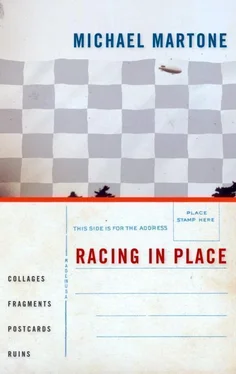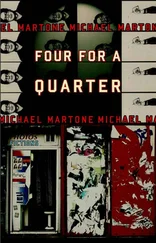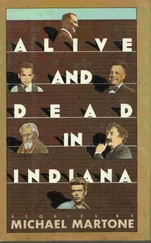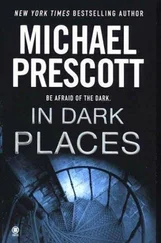An Essay on Attractive Nuisance
There is a ladder leaning against the Moon Winx Lodge sign. It casts its hard-edged repeating shadow on the underlying French curves of the sign's design, striping the moon, a kind of dazzleflage. No one's around. Perhaps this is evidence of routine maintenance. Paint needed to be scraped and touched up. Rust removed with some steel wool. Some glass tubing replaced or reconnected. A bird's nest in a dimpled cranny on the moon's cheek knocked down. The perspective of the ladder is inviting. Sighting up, it seems the side rails slant inward, that somewhere way overhead they will meet, a vanishing point within reach. But the ladder leads only up to the moon. I am reminded of the Italo Calvino fable involving ladders, the moon, and lost love. There are times when the moon seems that close, close enough to climb to, to clamor on. But that is always an illusion, a trick of light, the deficiency of our own limited sensing apparatus. There is delight, though, in possibility. The first rung is beneath your feet.
An Essay on Signs of Signs
I wonder who owns the Moon Winx Lodge sign. Probably the same person who owns the Moon Winx Lodge. The motel itself, brick colonial barracks arrayed on terraces behind the office hut, is worse for wear. A few rooms appear occupied, even lived in, the accommodations now week to week. The place has gone to seed, gone way past seedy. Now, no hourly rates offered for trysts or assignation. No, the house here has the air of flop-buckets with old-style mops and those extruded resin chairs, mismatched, on the shattered cement porches. The owner's let the place go. But the sign out front is another story. It's funny because the instrument for attracting the trade is now the attraction. The crescent moon curls inward, its horns pointing over to the ruined venue. Check it out, the moon urges. It has checked out. But you can't take your eyes off the sign. It looks brand new or, more exactly, brand old, an obvious relic of some pre-interstate motoring past, a past when air conditioning was a selling point, not simply a given. The lights all light. The paint is fresh. From the look of the sign, you would think this is a going concern instead of a place that is long gone. When did this happen? One day the owner awoke from a night of troubled dreams to discover the sign was the principal investment, was worth saving even as the rest of the property decays. Actual kudzu grows up the walls of one of the wings. The pool is fenced and filled in. The sign generates no cash that I can see, and yet it is maintained pristine. Tuscaloosa, Alabama, the South, maybe the whole country is fond of those cast-iron markers. The ones that are erected on historical sites, the ones that preserve memory, the ones that denote some significance. I can't wait for a sign commemorating the Moon Winx Lodge sign to be dedicated next to the Moon Winx Lodge sign. Not in the place where it once stood but right next to it. Perhaps the owner already dreams of this, is not waiting for a committee somewhere to act. The sign has already transubstantiated. It is an existential sign. It is itself. It stands for itself. It is its own memorial.
An Essay on Atmosphere
The novel Write Your Heart Out: Advice from the Moon Winx Motel was written by Geoff Schmitt and published in 2000 by Small Mouth Press. It is in the form of a writing how-to manual with insider tips, exercises, and prompts, but the story of its fictional author, down on his luck, bleeds through in a patchwork narrative. The picture of the sign on the cover of the book has been tinkered with. Lodge replaced by Motel. I suppose the revision was poetic. Motel seems the natural appellation, alliterative with Moon. But in the history of the Moon Winx Lodge, using "lodge" averted ones attention from "motel," its bad rap and rep. For a while the Moon Winx itself was associated with the Quality Courts, a loose cooperative of motels trying to spin the image. This is a classy joint, Quality said. There is something poignant and classic and very noir with the book's whole setup. The writer struggles with his work at a cheap desk in a crummy unkempt room while an oversized neon sign flashes hypnotically just outside the window, the window frame reframing the words, scrabbling the meaning. Geoff Schmitt went to writing school up the road at the university. I imagine him contemplating the sign just as his main character does, absorbing its aesthetic radiation, its atmospheric juice. Me too. That's me looking at the moon. A big chunk of that oversized moon fills my window as well. Its smiling bright-eye stare stares back at me. Then blinks.
An Essay on Night and Day
Glen House Sr. designed the Moon Winx Lodge sign in 1957, added the crowning touch of the crescent moon to the preexisting crossword of the Moon Winx Lodge. He told Rick Stoddart, an architectural writer, that it wasn't so much the medium of neon that excited him but the new Day-Glo paint he had on hand. The Moon Winx sign is really two signs. Night and day. The paint-bright yellow for the moon and pastel green for the placards with the cream-colored lettering-has its own charm. At night, the outlining neon in warm oranges and reds also interacts with the reactive paint. The cooler color tubes spelling out the name, announcing the restaurant (in a different font), the telephones, and the air conditioning, look, in the reflected illumination, as if they have been both burnished and embossed. The sign is scaffold shaped, with Moon Winx running horizontally at the top and Lodge a vertical slash, narrowing where it hits the scalloped base with "Restaurant" and "Air Conditioned" and "Telephones" footnoted there. The moon seems suspended from the craning sign. Its face is a sublime one with pronounced cheeks and chin, nose pugged, arched eyebrows, and a smile positively puckered, a Moon a Lisa. The profile works as the moon's topography, as the ragged shadow cast on a rough surface, a pimpled penumbra. The moon faces away from the road that was the main highway to Birmingham when the sign first went up. The moon then casts a coy eye over its shoulder. A come hither. The moon moons the highway, turning its back on the traffic, both shy and an exhibition. The contrasts are most striking. Day and night. Hot and cold color. The severe angular geometric alphabet wedged next to the sweeping free-hand sine curve of the animated moon.
An Essay on Auditing
The night auditor sits in the office of the Moon Winx Lodge. He can see, out the window, the famous neon sign of the motel, a two-story crescent moon, its man in the moon face outfitted with a winking eye. From where the night auditor sits, he sees the moon head on, the narrow leading edge of the contraption, its wide sides displayed to the cars passing on the street out front. He sees more of a line, a thick slice, the intricate cutouts and struts of the sign all flattened. There is little to do. The vacancy sign in the office window, so understated in comparison, is always lit. The books he keeps have been kept. The figures he adds to the folios have been summed up. Next to the desk is a small electrical box with the switches and breakers for the sign. One switch turns the neon lights off and on. The other controls the circuit that opens and closes the moon's electric eyes. The night auditor amuses himself through the endless night, turning the winking circuit off and on, off and on, off and on. It is a wink inside a wink. When the wink is on, the sign cycles through opening and closing its eye. But the night auditor can make the sign wink just by turning the eye on or off. Sometimes he fixes it so the eye stays closed. Sometimes he leaves the eye open, an insomniac moon. Or so you think as you drive past the Moon Winx Lodge. Who, you ask yourself, is operating this moon? It sometimes sleeps. Other times it is wide awake. And still other times its lids flutters as you drive by, both coming and going. The moon is dreaming. Rapid eye movement. It is a mystery and a gift as you commute.
Читать дальше












